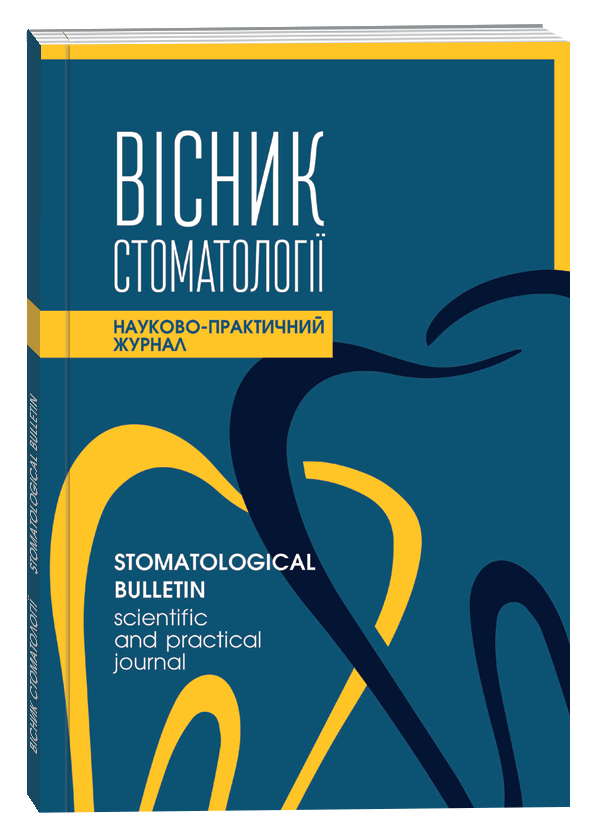DIRECT AND INDIRECT DENTAL RESTO-RATIONS: CLINICAL STATUS AND EVALUATION
DOI:
https://doi.org/10.35220/2078-8916-2020-35-1-26-30Keywords:
endodontically treated teeth, direct and indi-rect restoration, photocomposites, ceramic materials, clinical evaluationAbstract
To restore teeth after endodontic treatment, direct or in-direct restoration is used, but no common approaches are defined.
Purpose of work. Clinical evaluation of direct and indi-rect restoration of lateral group teeth after endodontic treatment in different follow-up periods.
Materials and methods. In a prospective randomized study, 79 individuals were examined in which 170 molars with class 2 cavities were restored (the Black method) af-ter endodontic treatment. In 38 patients, 89 teeth (52.4 %) were restored by direct method from a photocomposite, in 41 patients, 81 indirect restoration from a ceramic mate-rial was performed using digital technologies. The condi-tion of the restorations was assessed after 6 and 12 months according to clinical criteria.
Research result. Within 6 months, according to clinical criteria, violations were detected in 6 direct (6.7%) and 1 indirect restoration (1.2%). After 12 months, among di-rect restorations, 2 of them were found to be destroyed (2.2%), anatomical shape disorders were found in 6 res-torations (6.7%), marginal fit was found in 5 (5.6%), marginal staining was found in 9 restorations (10.1%), and contact point defects were found in 11 cases (12.4%). These violations occurred in 13 updates (14.6%). At the same time, the anatomical shape and edge fit were violat-ed only in 1 indirect restoration (1.2%), edge staining, as well as defects of the contact point, were detected in 2 restorations (2.5%). In General, there were 2 indirect res-torations with violations (2.5%). According to the results of two surveys, 19 direct restorations (21.3%) and 3 indi-rect restorations (3.7%) were detected with violations.
Conclusions. After endodontic treatment, it is advisable to restore the lateral teeth with ceramic materials using an indirect method.
References
Усевич Т. Л. Клиническое материаловедение в стоматологии / Т. Л. Усевич. ‒ М.: Феникс, 2015. ‒ 320 с.
Николаев А. И. Практическая терапевтическая стоматология : учеб. пособие / А. И. Николаев, Л. М. Цепов. – [9-е изд.] – М.: МЕДпресс-информ, 2017. – 928 с.
Абакаров С. И. Микропротезирование в стома-тологии / Абакаров С. И., Сорокин Д. В., Абакарова Д. С. ‒ М.: ГЭОТАР-Медиа, 2019. ‒ 384 с.
Modern Operative Dentistry: Principles for Clinical Practice // Carlos Rocha Gomes Torres. - Switzerland AG.: Springer Nature, ‒ 2019. ‒ 715 p.
Насруллаев Р. К. Метод горячей вертикальной конденсации гуттаперчи, как один из критериев успеха эндодонтического лечения / Р. К. Насруллаев // Бюллетень медицинских интернет-конференций. ‒ 2015. ‒ №10. ‒ С. 1193-1193.
Основы препарирования зубов для изготовления литых металлических, металлокерамических и керамических реставраций // Г. Шиллинбург, Р. Якоби, С. Бракетт / Пер.: А. Суркин, А. Островский. ‒ М.: Азбука, 2006. – 400 с.
Микиєвич Н. І. Порівняльна клінічна оцінка ефективності лікування дефектів твердих тканин бічних зубів прямими і непрямими реставраціями, виготовленими з композитних матеріалів / Н. І. Микиєвич // Український стоматологічний альманах. ‒ 2018. ‒ №1. ‒ С. 40-46.
Fatigue behavior of resin-modified monolithic CAD-CAM RNC crowns and endocrowns / G. T. Rocca, P. Sedlakova, C. M. Saratti [et al.] // Dent Mater. ‒ 2016. ‒ №32(12). ‒ P. 338‐350.
Севбитов А. В. Введение в кариесологию и па-родонтологию / А. В. Севбитов. – М.: Феникс, 2015. ‒ 141 с.









